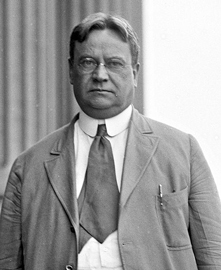
Monday marked the 100th anniversary of the landmark California election that introduced the initiative, the referendum, and the recall. AP last weekend ran a good history of these populist instruments of governance, including the political conditions that gave rise to them:
By the time of the statewide election on Oct. 10, 1911, voter discontent had reached a crescendo, with Californians feeling frustrated and disenfranchised.
Stories of political corruption and bribery trials of corporate executives and labor leaders were fixtures of the newspapers. The Southern Pacific Railroad controlled nearly every lever of power in California, including many of the state’s largest newspapers that were beholden to its advertising revenue. Lawmakers rode the rails for free and dined on the company’s dime.
Hiram Johnson, an upstart lawyer who had tried to elicit change from outside the halls of power, seized the moment. In his 1910 campaign for governor, he promised to end the tyranny of robber baron railroad officials and return power to the masses.
A hundred years later, there's a pretty widespread notion that the state’s ability to govern itself is broken, and some would say the tools of direct democracy forged in that bygone era are important contributing factors to the current lack of efficacy.
I asked KQED's resident expert on state government, Sacramento Bureau Chief John Myers, about the debate.
"There are two pretty indisputable facts about the system of direct democracy," Myers says. "First, one tool in particular -- the initiative -- is used far more than the other two (the referendum and the recall). And second, Californians, as measured in poll after poll, like having the power to take matters into their own hands.
That's not to say that Californians don't think there are ways to make the process better. But for all its flaws, voters like having a say on writing laws and amending the state's constitution."